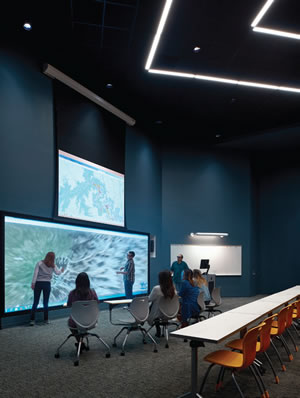Reimagine Education With AV
“Unless you have an engaged student,
learning is out the door. It’s all about experience,” says Sharon
Crawford, studio director for global design and architecture
firm Gensler. Crawford was speaking during EDspaces 2019, a
conference exploring the future of educational facilities. “There
aren’t any ‘average’ learners now, so designing a space for this
average learner is just a myth.”

Project: Ventura College Applied Science Center | Architect and Designer: Gensler | Image Credit: Gensler/Ryan Gobuty
Crawford joined a panel discussion titled “Integrating the
Digital with the Physical to Create the Campus of the Future,”
moderated by AVIXA and including Ron Cramer, Strategic
Learning consultant for the University of Wisconsin-Madison;
and Craig Park, principal at technology consulting firm
The Sextant Group. The panel agreed that with audiovisual
experiences what they are today, students arrive at college
expecting a certain level of tech-enabled education, customized
to fit the way they prefer to learn. To that end, workspaces
must be designed to offer flexibility, including technology that
can handle distance learning one day and interactive group
collaboration the next.
“Students come with an expectation that technology will be
available to them in the classroom,” says Park. “Older faculty,
in many ways, don’t teach that way, so we’re at this point
where students have a high degree of expectation for access,
and it’s not yet been universally cooked into the pedagogical
approach.”
BYOD to Campus
At many colleges and universities, that means blending
students’ own digital devices into the learning experience.
“Whatever the configuration in the space, for whatever the
methodology the instructor was using, it had to support
BYOD [bring your own device],” explained Cramer, referring
to a study his team did of the classroom requirements
for enabling digital- and audiovisual-based learning. In
Wisconsin’s case, doing so led to a significant build-out of the
school’s wireless network infrastructure, not only to handle
data traffic from mobile devices, but also to support new types
of wireless solutions, such as collaboration systems that allow
faculty and staff to share information from their laptops on
interactive displays or projection screens.
“So much of education has shifted to team-based learning
experiences,” says Park. In order to allow students to work
in cohorts of four to eight, he continues, college classrooms
should be designed so people can easily connect to the available
room technology. “More often than not, the complaint we get
that prevents people from accepting new technology is, ‘Is it
easy to connect to?’”
Tech-Friendly Spaces
and Active Learning
Of course, the best and easiest-to-use digital technology
does little for students and faculty if the physical classrooms
aren’t designed with collaboration in mind. Increasingly,
colleges are creating active-learning lecture halls, with tiered
workspaces and distributed, shared displays for making
small-group connections. When there’s no lecture, students
turn their chairs to congregate in groups around the different
displays and wirelessly share, annotate, and preserve digital
information from mobile devices.
At the University of Missouri-Kansas City School of
Business, there’s even been a push to eliminate certain
auditoria in favor of smaller, tech-enabled collaboration
spaces. “There was a demand for small huddle spaces, six- to
eight-person conference rooms, which they call ‘venture
accelerators,’” Park says.
Looking ahead, the EDspaces panelists were eager to see
how campuses would integrate artificial intelligence and other
leading-edge technologies. For example, using voice control to
activate presentation systems and navigate shared education
resources could streamline information discovery and lead
to new ways of learning. Studies indicate that technology-enabled,
team-based learning leads to better learning
outcomes. More digital information and the digital tools to put
it to use should continue to revolutionize higher education.
“We’re going to see more data infusion, and that’s going to
lead to greater personalized learning,” says Cramer. “But that
won’t change the fact that we need to have shared experiences
that help us learn as teams.”
AVIXA™ is the Audiovisual and Integrated Experience
Association, which represents the $231-billion global
commercial AV industry and produces InfoComm trade shows
around the world. To find out more, visit www.avixa.org/higheredAV.
This article originally appeared in the November/December 2019 issue of Spaces4Learning.